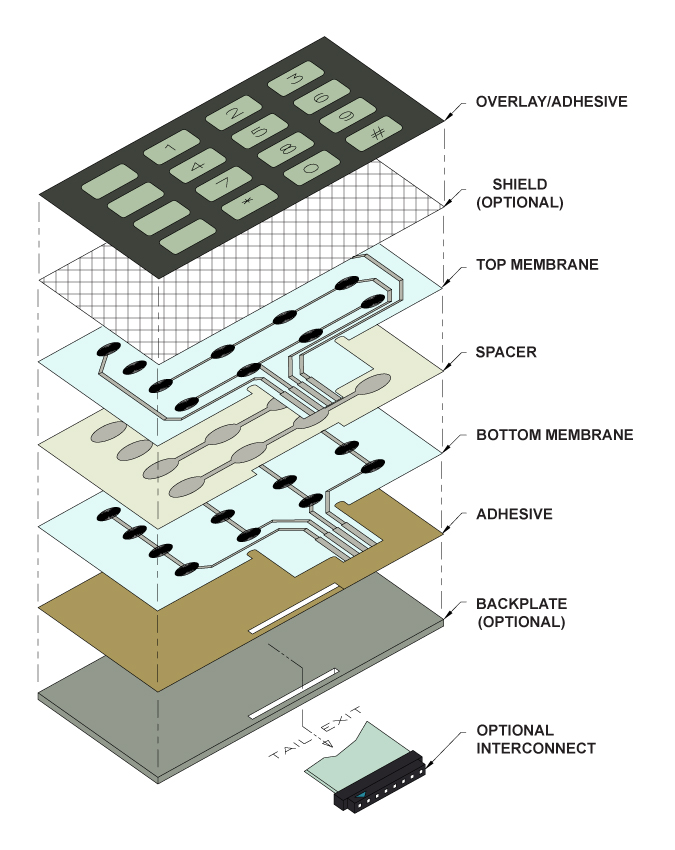Why Membrane Changes Are Vital for Sturdy Control Solution
Membrane layer buttons play an essential function in guaranteeing the longevity and integrity of control systems throughout different markets. Their distinct construction allows them to sustain tough ecological aspects such as moisture, temperature extremes, and physical wear. This strength not just prolongs the lifespan of the systems they serve but additionally lessens maintenance needs. As we check out the diverse advantages of membrane layer switches, it becomes obvious that their significance goes beyond simple functionality, affecting customer experience and functional effectiveness. What further effects do these attributes hold for the future of control system design?
Review of Membrane Switches
Membrane layer buttons are functional and dependable elements generally utilized in different electronic control systems. These buttons include numerous layers, consisting of a graphic overlay, a spacer layer, and a published circuit layer. The visuals overlay gives both practical and visual style, while the spacer layer guarantees that the buttons are triggered just when pressed. The printed circuit layer consists of conductive traces that finish an electric circuit when the membrane layer is pressed, enabling the gadget to reply to customer inputs.
Membrane switches are typically preferred in applications calling for a portable and light-weight design, making them excellent for portable tools, clinical devices, and industrial machinery. They can be personalized to fulfill certain customer needs and can incorporate different functions such as backlighting, tactile feedback, and numerous shades. Furthermore, membrane buttons are resistant to dirt, wetness, and pollutants, making them appropriate for environments where sturdiness is vital.
Advantages of Longevity
In lots of applications, the longevity of membrane layer changes offers substantial advantages that enhance their overall efficiency and dependability. These buttons are created to endure severe settings, making them excellent for use popular problems such as high humidity, extreme temperature levels, and exposure to chemicals. Their durable construction aids to avoid damages from physical impact, making certain lasting capability and lessening the demand for constant replacements.
In addition, membrane switches are resistant to deterioration, which is essential in applications where regular communication happens. This longevity translates to decrease maintenance prices, as organizations benefit from lowered downtime and fewer service interruptions. The encapsulated design of membrane changes shields internal components from dust and wetness access, additional adding to their life expectancy (membrane switch).
An additional advantage is their capability to preserve consistent performance gradually. With a high resistance for mechanical stress and anxiety, these switches preserve their responsive responses and electrical integrity, guaranteeing individual satisfaction. Eventually, the durability of membrane switches not only enhances functional performance however additionally fosters confidence in their dependability, making them a favored selection for control systems throughout numerous sectors.
Applications in Various Industries
Durable control systems employing membrane layer buttons locate extensive applications throughout an array of industries, each profiting from the special features these buttons use. In the medical industry, membrane buttons are critical for tools such as person monitors and analysis devices, where reliability and convenience of cleansing are vital. Their resistance to dampness and impurities guarantees they maintain capability in clean and sterile atmospheres.
The automobile market leverages membrane buttons for dashboard controls page and infomercial systems, where they supply smooth, low-profile user interfaces that enhance individual experience. These buttons are additionally created to endure harsh problems, including direct exposure to severe temperatures and resonances.
In commercial settings, membrane switches are commonly made use of in machinery control board, providing tactile responses and toughness required for high-usage applications. Their capacity to withstand chemicals makes them appropriate for producing settings where spills and pollutants are constant.

Consumer electronic devices, such as kitchen devices and remote controls, likewise make use of membrane switches for their versatility and cost-effectiveness. Generally, the flexibility and robust nature of membrane changes make them essential across different fields, guaranteeing effective operation and long life in control systems.
Layout and Aesthetic Appeal
While performance is vital, the style and aesthetic appeal of control systems furnished with membrane buttons play an essential duty in user engagement and overall experience (membrane switch). The visual design of these switches can significantly influence customer understanding and communication. A well-designed membrane layer button improves the appearance of the tool, making it more attractive to individuals and promoting a link between the customer and the item
Membrane layer changes use a large amount of versatility in design, allowing producers to customize graphics, shades, and textures to align with brand name identification and product aesthetics. Making use of lively shades and unique patterns can draw attention, while responsive feedback can reinforce the user's communication with the tool. Furthermore, the capability to incorporate LED indications and backlighting right into the membrane switch layout supplies both useful and visual benefits, enhancing presence and use in various environments.

Enhancing Individual Experience

Moreover, membrane layer buttons can be customized to incorporate graphical interfaces, improving use by providing information in a clear and intuitive way (membrane switch). This modification can consist of symbols, labels, and shade coding that overview users through complex functionalities with simplicity. Furthermore, their convenience allows for assimilation in numerous settings, ensuring regular efficiency whether in commercial machinery or customer electronic devices
The longevity of membrane layer buttons likewise plays an navigate to these guys essential duty in user experience. By standing up to extreme problems and prolonged use, these switches lower the probability of system failings, therefore promoting reliability and user self-confidence. Eventually, the strategic use of membrane layer changes not only boosts capability however also significantly enhances user communication with control systems, making them an indispensable component in modern-day style.
Conclusion
